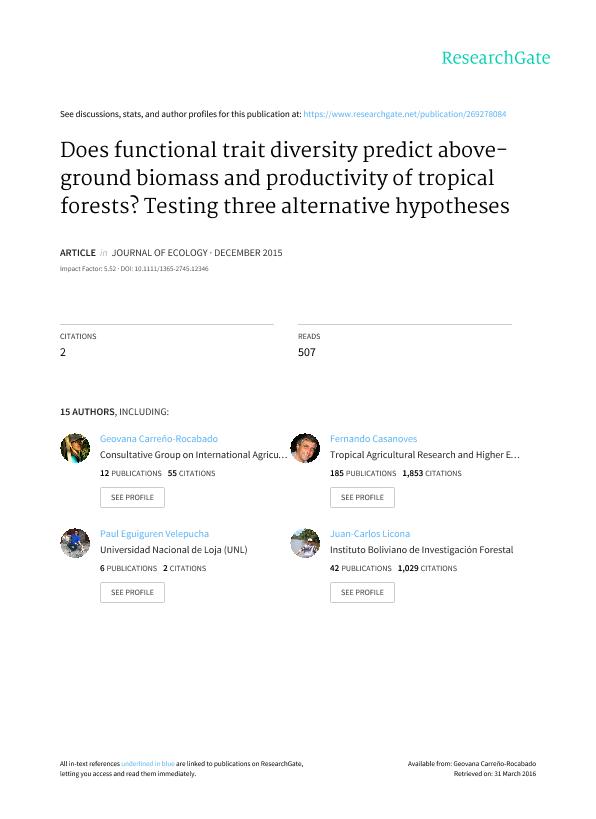Artículo
Does functional trait diversity predict aboveground biomass and productivity of tropical forests? Testing three alternative hypotheses
Finegan, B.; Peña Claros, Marielos; de Oliveira, Alexandre; Ascarrunz, Nataly; Bret Harte, M. Syndonia; Carreno Rocabado, Geovana; Casanoves, Fernando; Diaz, Sandra Myrna ; Eguiguren Velepucha, Paul; Fernandez, Fernando; Licona, Juan Carlos; Lorenzo, Leda; Salgado Negret, Beatriz; Vaz, Marcel; Poorter, Lourens
; Eguiguren Velepucha, Paul; Fernandez, Fernando; Licona, Juan Carlos; Lorenzo, Leda; Salgado Negret, Beatriz; Vaz, Marcel; Poorter, Lourens
 ; Eguiguren Velepucha, Paul; Fernandez, Fernando; Licona, Juan Carlos; Lorenzo, Leda; Salgado Negret, Beatriz; Vaz, Marcel; Poorter, Lourens
; Eguiguren Velepucha, Paul; Fernandez, Fernando; Licona, Juan Carlos; Lorenzo, Leda; Salgado Negret, Beatriz; Vaz, Marcel; Poorter, Lourens
Fecha de publicación:
01/2015
Editorial:
Wiley Blackwell Publishing, Inc
Revista:
Journal Of Ecology
ISSN:
0022-0477
1365-2745
1365-2745
Idioma:
Inglés
Tipo de recurso:
Artículo publicado
Clasificación temática:
Resumen
Tropical forests are globally important, but it is not clear whether biodiversity enhances carbon storage and sequestration in them. We tested this relationship focusing on components of functional trait biodiversity as predictors. Data are presented for three rain forests in Bolivia, Brazil and Costa Rica. Initial above-ground biomass and biomass increments of survivors, recruits and survivors + recruits (total) were estimated for trees ≥10 cm d.b.h. in 62 and 21 1.0-ha plots, respectively. We determined relationships of biomass increments to initial standing biomass (AGBi), biomass-weighted community mean values (CWM) of eight functional traits and four functional trait variety indices (functional richness, functional evenness, functional diversity and functional dispersion). The forest continuum sampled ranged from ‘slow’ stands dominated by trees with tough tissues and high AGBi, to ‘fast’ stands dominated by trees with soft, nutrient-rich leaves, lighter woods and lower AGBi. We tested whether AGBi and biomass increments were related to the CWM trait values of the dominant species in the system (the biomass ratio hypothesis), to the variety of functional trait values (the niche complementarity hypothesis), or in the case of biomass increments, simply to initial standing biomass (the green soup hypothesis). CWMs were reasonable bivariate predictors of AGBi and biomass increments, with CWM specific leaf area SLA, CWM leaf nitrogen content, CWM force to tear the leaf, CWM maximum adult height Hmax and CWM wood specific gravity the most important. AGBi was also a reasonable predictor of the three measures of biomass increment. In best-fit multiple regression models, CWMHmax was the most important predictor of initial standing biomass AGBi. Only leaf traits were selected in the best models for biomass increment; CWM SLA was the most important predictor, with the expected positive relationship. There were no relationships of functional variety indices to biomass increments, and AGBi was the only predictor for biomass increments from recruits. Synthesis. We found no support for the niche complementarity hypothesis and support for the green soup hypothesis only for biomass increments of recruits. We have strong support for the biomass ratio hypothesis. CWMHmax is a strong driver of ecosystem biomass and carbon storage and CWM SLA, and other CWM leaf traits are especially important for biomass increments and carbon sequestration.
Archivos asociados
Licencia
Identificadores
Colecciones
Articulos(IMBIV)
Articulos de INST.MULTIDISCIPL.DE BIOLOGIA VEGETAL (P)
Articulos de INST.MULTIDISCIPL.DE BIOLOGIA VEGETAL (P)
Citación
Finegan, B.; Peña Claros, Marielos; de Oliveira, Alexandre; Ascarrunz, Nataly; Bret Harte, M. Syndonia; et al.; Does functional trait diversity predict aboveground biomass and productivity of tropical forests? Testing three alternative hypotheses; Wiley Blackwell Publishing, Inc; Journal Of Ecology; 103; 1; 1-2015; 191-201
Compartir
Altmétricas



